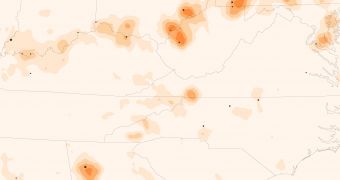Studies conducted using satellites confirm ground-based measurements indicating that sulfur dioxide levels across the eastern seaboard of the United States are decreasing. The fact that such investigations can be conducted from space has great implications for global SO2 monitoring.
Sulfur dioxide is a dangerous pollutant, and the main trigger of acid rains. In the US particularly, about 67 percent of concentrations are generated by coal power plants. Since 2005, pollution levels from these sources has dropped by about 50 percent.
The orbital study was carried out by the NASA Aura satellite, using the Ozone Monitoring Instrument (OMI). Details of the work appear in this month's issue of the esteemed Geophysical Research Letters.
Based on these encouraging results, investigators now want to extend satellite-based pollutants monitoring to areas of interest around the world. This could have been done a long time ago, but experts first needed to ensure that the data satellites can collect are in tune with reality.
This is why the ground-based measurements were used as reference point. Satellite-acquired data were found to be tremendously precise, so monitoring studies can now be extended over areas of the world that have little to no infrastructure for conducting ground-based research.
According to the experts behind the new study, the US Environmental Protection Agency (EPA) is largely to be commended for the sharp SO2 decline. In 2005, the federal agency passed the Clean Air Interstate Rule, whose role was to promote a sharp decrease in sulfur dioxide emissions.
One of the primary consequences of passing this act was the installation of desulfurization instruments on many of the coal power plants on the eastern seaboard. Additionally, emission levels were also capped, allowing plant operators to sell and buy pollution credits.
“Vitali has developed an extremely powerful technique that makes it possible to detect emissions even when levels of sulfur dioxide are about four times lower than what we could detect previously,” expert Nickolay Krotkov says of Environment Canada expert and study leader, Vitali Fioletov.
Krotkow, himself a coauthor on the new paper, holds an appointment as a research scientist at the NASA Goddard Space Flight Center (GSFC), in Greenbelt, Maryland. Statistics estimate that coal power plants release as much as 70 kilotons of SO2 annually.
“What we’re seeing in these satellite observations represents a major environmental accomplishment. This is a huge success story for the EPA and the Clean Air Interstate Rule,” EPA scientist Bryan Bloomer concludes.

 14 DAY TRIAL //
14 DAY TRIAL //